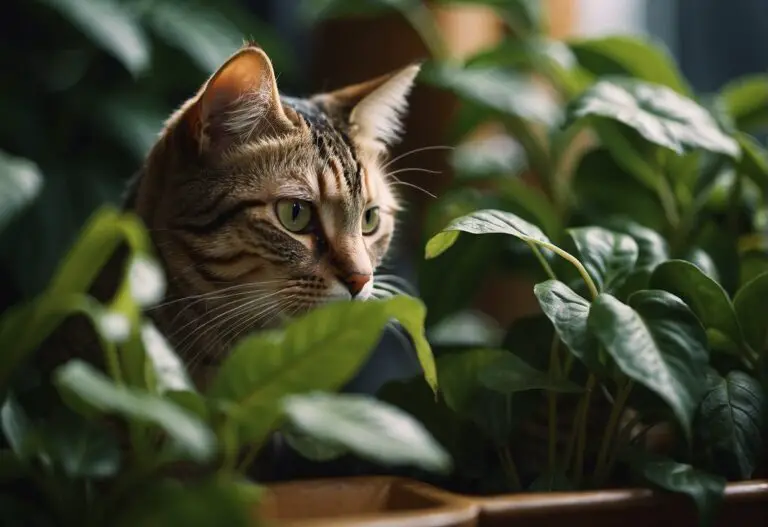Lady Banks Rose Problems: Common Issues and How to Solve Them
Lady Banks roses are a beautiful addition to any garden with their delicate, fragrant blooms and thornless branches. However, like any plant, they can encounter problems that may affect their growth and beauty. In this article, we will discuss some of the common problems that Lady Banks roses may face and how to prevent and solve them.
One of the most common problems that Lady Banks roses face is powdery mildew, which appears as a white or grayish powder on the leaves of the plant. Another issue is black spot fungus, which causes black spots to appear on the leaves.
Additionally, Lady Banks roses can be affected by rose canker, which causes brown or gray cankers to form on the stems of the plant. These issues can be frustrating for gardeners, but with proper care and attention, they can be prevented and managed.
Key Takeaways
- Lady Banks roses can encounter problems like powdery mildew, black spot fungus, and rose canker.
- Proper care and attention can help prevent and manage these issues.
- Regular pruning, good air circulation, and proper watering are essential for keeping Lady Banks roses healthy.

Lady Banks Rose Problems
Lady Banks Rose is a beautiful climbing rose with almost no thorns and large flower clusters. However, like any other plant, it is not immune to problems.
In this section, we’ll take a look at some of the common problems that you may encounter while growing Lady Banks Rose.
Powdery Mildew
Powdery mildew is a fungal disease that affects many plants, including Lady Banks Rose. It appears as a white powdery coating on the leaves, stems, and buds of the plant. If left untreated, it can cause the leaves to turn yellow and fall off, weakening the plant.
To prevent powdery mildew, make sure your Lady Banks Rose is planted in a location with good air circulation and receives plenty of sunlight. Avoid overhead watering, as the moisture can promote the growth of the fungus.
If you notice powdery mildew, treat the plant with a fungicide according to the manufacturer’s instructions.
Aphids
Aphids are small insects that can infest Lady Banks Rose. They feed on the plant’s sap, causing the leaves to curl and distort. They also excrete a sticky substance called honeydew, which can attract ants and other insects.
To get rid of aphids, spray the plant with a strong stream of water to knock them off. You can also use insecticidal soap or neem oil to kill them. Lady Banks Rose is generally resistant to aphids, so if you notice a severe infestation, it may be a sign of an underlying problem.
Black Spot
Black spot is a fungal disease that affects many types of roses, including Lady Banks Rose. It appears as black spots on the leaves, which can cause them to yellow and fall off. If left untreated, it can weaken the plant and make it more susceptible to other diseases.
To prevent black spot, make sure your Lady Banks Rose is planted in a location with good air circulation and receives plenty of sunlight. Avoid overhead watering, as the moisture can promote the growth of the fungus. If you notice black spot, treat the plant with a fungicide according to the manufacturer’s instructions.
Causes of Common Problems
If you’re experiencing problems with your Lady Banks rose, don’t worry, you’re not alone. Lady Banks roses are generally hardy and low maintenance, but they can still be susceptible to a few common issues.
Here are some possible causes of common problems you may face with your Lady Banks rose.
Overwatering
One of the most common problems with Lady Banks roses is overwatering. These roses prefer well-draining soil, and if the soil is too wet, the roots can become waterlogged and start to rot. This can cause yellowing leaves, stunted growth, and even death of the plant.
To prevent overwatering, make sure the soil is dry to the touch before watering, and avoid watering too frequently.
Lack of Sunlight
Lady Banks roses require full sun to thrive, and if they don’t receive enough sunlight, they may become weak and susceptible to disease.
If your rose is not getting enough sun, you may notice fewer blooms and slower growth. Make sure your rose is planted in a spot that receives at least six hours of direct sunlight per day.
Pests and Diseases
Lady Banks roses are generally resistant to pests and diseases, but they can still be affected by a few common issues. Aphids, spider mites, and thrips can all damage the leaves and stems of your rose, and fungal diseases like black spot and powdery mildew can cause yellowing leaves and stunted growth.
To prevent pests and diseases, keep your rose healthy with proper watering and fertilization, and prune away any infected or damaged leaves and stems.
Improper Pruning
Pruning is an important part of maintaining your Lady Banks rose, but improper pruning can cause more harm than good. If you prune your rose too much, you may remove too many healthy canes and reduce the number of blooms you get.
On the other hand, if you don’t prune enough, your rose may become overgrown and tangled. To prevent improper pruning, make sure you use sharp, clean pruning shears and follow proper pruning techniques.
Lack of Fertilization
Lady Banks roses are heavy feeders, and if they don’t receive enough nutrients, they may become weak and susceptible to disease. To keep your rose healthy, fertilize it regularly with a balanced fertilizer, and make sure to follow the manufacturer’s instructions for application.
By understanding the common problems that can affect your Lady Banks rose, you can take steps to prevent them and keep your rose healthy and thriving.
Prevention and Solutions
Now that you know about the common problems that Lady Banks Roses may face, it’s time to learn how to prevent and solve them. Here are some tips to keep your Lady Banks Rose healthy and blooming:
Prevention
- Choose a suitable location for your Lady Banks Rose. It needs plenty of sunlight and well-drained soil to thrive.
- Water your Lady Banks Rose regularly, but don’t overwater it. Too much water can cause root rot.
- Fertilize your Lady Banks Rose regularly with a balanced fertilizer. Follow the instructions on the package carefully.
- Prune your Lady Banks Rose regularly to remove dead or diseased branches and to promote healthy growth.
- Keep an eye out for pests and diseases. Early detection is key to preventing them from spreading.
Solutions
- If your Lady Banks Rose is infested with aphids, you can spray it with a mixture of water and dish soap. This will suffocate the aphids and prevent them from reproducing.
- If your Lady Banks Rose has yellow leaves, it may be a sign of nitrogen deficiency. You can fertilize it with a nitrogen-rich fertilizer to solve this problem.
- If your Lady Banks Rose has black spots on its leaves, it may be a sign of black spot disease. You can treat it with a fungicide spray.
- If your Lady Banks Rose has powdery mildew, you can treat it with a mixture of water and baking soda. This will kill the fungus and prevent it from spreading.
- If your Lady Banks Rose has root rot, you may need to dig it up and replant it in a new location with well-drained soil.
Remember, prevention is always better than cure. By taking good care of your Lady Banks Rose and keeping an eye out for problems, you can prevent most issues from occurring in the first place.
Proper Care for Lady Banks Rose
Lady Banks Rose is a beautiful and delicate plant that requires proper care to thrive. Here are some tips to ensure your Lady Banks Rose stays healthy and vibrant:
Planting
When planting Lady Banks Rose, choose a location with well-draining soil and full sun exposure. Lady Banks Rose can tolerate partial shade, but it will not bloom as well. Make sure to plant it away from other plants, as it can become invasive and take over the area.
Watering
Lady Banks Rose is drought-tolerant and can survive on little water, but it thrives with regular watering. Water the plant deeply once a week, especially during hot and dry weather. Avoid overwatering, as this can lead to root rot and other diseases.
Fertilizing
Fertilize Lady Banks Rose once a year in the spring with a balanced fertilizer. Avoid fertilizing in the fall, as this can stimulate new growth that may not have time to harden off before winter.
Pruning
Prune Lady Banks Rose in the late spring or early summer after it has finished blooming. Remove any dead or diseased wood, and cut back any overgrown or wayward branches. Lady Banks Rose does not require heavy pruning, but it can be trained to grow on a trellis or arbor.
Pest and Disease Control
Lady Banks Rose is generally disease-resistant and pest-free, but it can be susceptible to aphids and spider mites. If you notice any infestations, spray the plant with a strong stream of water or use an insecticidal soap. Avoid using harsh chemicals, as these can harm beneficial insects and pollinators.
Lady Banks Rose is a beautiful and low-maintenance plant that can add color and charm to any garden. With proper care and attention, your Lady Banks Rose will thrive and bloom for years to come.
Frequently Asked Questions (FAQs)
What is the blooming season for Lady Banks rose?
Lady Banks rose blooms in the spring, usually from March to May. The blooms are usually yellow or white and are very fragrant.
Where is the best place to plant Lady Banks rose?
Lady Banks rose is a very hardy plant and can grow in most soil types. However, it prefers well-drained soil and full sun exposure. It is best to plant it in a location where it can receive at least six hours of sunlight per day.
How fast does Lady Banks rose grow?
Lady Banks rose is a fast-growing plant and can grow up to 20 feet in one season. It is important to provide support for the plant as it grows, such as a trellis or fence.
Do Lady Banks roses need pruning?
Lady Banks rose does not require regular pruning, but it can benefit from occasional pruning to shape the plant or remove dead or diseased branches. Pruning should be done in the late winter or early spring.
What is the best trellis for Lady Banks rose?
Lady Banks rose can grow very large and heavy, so it is important to provide a strong and sturdy trellis. A metal or wooden trellis is recommended, and it should be anchored securely to the ground.
Why won’t my Lady Banks rose bloom?
There are several reasons why a Lady Banks rose may not bloom. One common reason is that it is not receiving enough sunlight. Another reason may be that it is not being fertilized enough. Lady Banks rose should be fertilized in the spring with a balanced fertilizer.
Conclusion
In conclusion, the Lady Banks rose is a beautiful and hardy plant that can thrive in a variety of conditions. However, it is not immune to problems, and as a gardener, you should be aware of the potential issues that may arise.
If you are experiencing problems with your Lady Banks rose, the first step is to identify the issue. This can be done by examining the plant for signs of disease or pests, and by considering any environmental factors that may be affecting its growth.
Once you have identified the problem, there are several steps you can take to address it. These may include pruning, fertilizing, watering, or treating the plant with pesticides or other chemicals.
It is important to note that some problems may be beyond your control, and in these cases, it may be best to simply remove the plant and start fresh with a new one.
Overall, the Lady Banks rose is a wonderful addition to any garden, and with proper care and attention, it can provide years of beauty and enjoyment. So if you are considering adding this lovely plant to your landscape, be sure to keep these tips in mind to ensure its success.






I have several Lutea Bank’s Yellow Rose. Each plant sprouts several fast growing ‘shooters’ not from the root but from the branches. How should I deal with this problem?
fast-growing shoots sprouting from the branches of your Lutea Banksia Rose can be managed through pruning. You should trim or prune these shoots regularly to control their growth and maintain the desired shape and size of the rose plant.